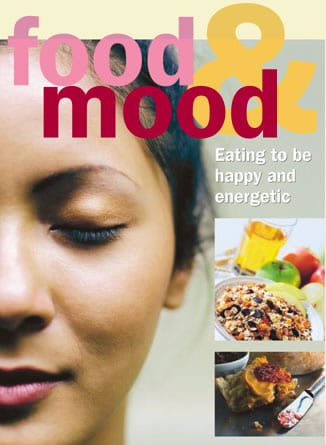Food & mood
by Karen McGeorge Sanders
This article was originally published in January 2004

Eating to be happy and energetic
- About brain chemicals
- Stressors and supporters
- Foods high in key amino acids
- Protein, carbohydrates and fiber
- Tempeh Spaghetti Sauce
- FoodWorks classes on Food and Mood
“A common New Year’s resolution is to eat better to lose weight. Here’s a look at how food choices affect us — beyond the numbers on the scale.”
(January 2004) — Dr. Jekyll, a thoughtful, gentle physician, swallows his experimental formula and turns into angry, dangerous Mr. Hyde. Fiction, certainly. Yet maybe the classic fantasy is an exaggerated truth of what happens as millions of people order a latte as breakfast or search for a midday pick-me-up.
Food has long been suspected of affecting moods. Three thousand years ago Indian sages observed that many people felt irritable and fatigued in the afternoon, which is reflected today in the traditional “tea time,” coffee break or visit to the nearest vending machine. Recently research has focused on how the food choices people make affects their moods and energy levels.
“We see people who suffer both from low energy and mood swings,” says Kathleen Putnam M.S., a registered dietician who, partnered with Sandi Kaplan M.S., R.D., runs NutritionWorks Nutrition Consulting and teaches a mood and food class for PCC.
Brain messengers
Neurotransmitters are the biochemical messengers of the brain and central to the theories about how food affects mood. Research has linked neurotransmitter imbalances to problems such as fatigue, depression and aggression. The neurotransmitters most sensitive to diet are serotonin and dopamine, along with dopamine’s offshoots norepinephrine and epinephrine (adrenaline). These neurotransmitters are synthesized from the amino acids in proteins.
So will eating a meal high in protein help feed your mood? Experts say protein will help provide the amino acids needed to produce dopamine and a sense of alertness, excitement and mental acuity, but a high protein meal also actually lowers serotonin, the neurotransmitter needed for a sense of optimism, relaxation and well-being. Eating a lot of protein, therefore, is not a good simple answer.
Eating carbs with your proteins will change the chemical dynamic. The reason is that carbs trigger a process that allows tryptophan to flood the brain, where it’s converted into serotonin and provides for that sense of well-being.

It sounds simple: just eat protein for mental energy and carbohydrates for relaxation. Unfortunately, it’s not that easy. Much is theory, as researchers can’t measure neurotransmittors like serotonin in the brain and instead rely on subjective data like asking people how they feel after eating certain foods. Also, foods are often composed of several nutrients that interact to affect neurotransmittor production.
Beyond carbohydrates and protein
For many people highs and lows in mood and energy can be linked to blood sugar levels. “Sugar, particularly refined sugar, gives a real high. There’s almost no digestion that needs to occur, so it is absorbed in minutes. This causes the pancreas to release insulin to get the sugar into the cells.
“The energy high occurs quickly, within 10 to 15 minutes. But because there’s little digestion, there is a rapid rise in blood sugar, so you get a real spike, then it quickly wears off. Many get a rebound effect and experience low blood sugar after their high and are low energy again. Many are back at the vending machine in an hour or two looking for another boost,” explains Putnam.
A better solution is to eat slower digesting carbohydrates, especially those high in fiber and nutrients, which slows the rate of digestion. These include whole-grain breads, cereals and pastas, rice, fruit and vegetables. This helps keep both mood and energy at a constant level instead of experiencing dramatic swings. Some people also are using a food’s glycemic index to make food choices.
“The glycemic index uses a scale of 0 to 100 to measure the response of blood sugar to a particular food,” explains Kaplan. It was popularized by the book, The GI Factor, by Dr. Leeds and J.B. Miller. Pure glucose can be absorbed undigested into the bloodstream to produce the maximum effect on blood glucose in the shortest time, and is given the highest score of 100. Therefore, foods with low glycemic indexes are preferred, since they don’t raise the blood sugar as much, thus avoiding sugar highs and “rebound hypoglycemia.” Some foods with low glycemic indexes include legumes, carrots, peas, apples, pears, yams, rye bread, rice bran and other whole grains.
Another consideration for food and mood is fat. Fat slows digestion and is believed to release morphine-like chemicals called endorphins that stimulate a sense of euphoria. Some fats, like drizzling olive oil on pasta, can help keep mood constant. Fat, however, is often combined with high amounts of sugar to create treats that can give susceptible people mood swings.
Many people also have problems with wheat and dairy products. According to Putnam, “Wheat and dairy products are overused staples in the American diet. Some people may develop intolerances to these products, which improve when consuming less wheat and dairy. In our class we look at tasty alternatives to achieve this, although it’s not an issue for everyone.”
Traumatic trio
Some foods are famous for their mood- altering capabilities. We’ll look at three — caffeine, chocolate and alcohol — to see their effects.
Caffeine (or trimethylxanthine) is a mood stimulant found in coffee, some teas and sodas. In the United States, 50 percent of people drink more than 300 milligrams daily, which is about three six-ounce cups of coffee or six cans of caffeinated soda. Caffeine works by binding to receptors and increasing brain neural firing. The body assumes an emergency state and releases adrenaline, the “fight-or-flight” response.
So one or two cups can make a person more alert, but too much can cause the jitters. “Coffee gives you that quick rush of adrenaline, activating the ‘fight-or-flight’ response, raising blood pressure and pulse, making you wired as if you’re being chased by a tiger. You get a burst of energy, then crash. This is great for escaping tigers, but people today aren’t fighting tigers, so coffee can stress out our bodies,” says Kaplan.
Prolonged alcohol abuse can cause the brain to atrophy and impairs activity in the receptors needed for memory and learning. (See www.life-enhancement.com, “Reducing aggression and violence: the serotonin connection” by Lane Lenard, Ph.D.) “Many alcoholic beverages also contain sugar, which causes a spike, so it’s best to have it with food, like wine with a meal,” recommends Kaplan.
Many people have chocolate cravings, with North Americans consuming $700 million weekly. Chocolate is a delectable combination of sugar and fat, with other mood-stimulating chemicals. One chemical, phenylethylamine, releases energy-pleasing endorphins. Chocolate also contains a substance similar to caffeine that can give chocolate lovers a coffee-like buzz. However, chocolate can cause mood swings as the sugar is quickly digested.
Eating happy
So what can people eat to feel good? Some experts suggest foods as a way to customize your mood. Drs. Richard and Judith Wurtman, leaders in the field of food affecting mood, suggest that for the most beneficial effects of carbohydrates and protein, eat them separately. Eat protein to stay alert and carbohydrates to soothe. “So if someone’s at home and the world is falling apart, he should just pop a potato in the microwave,” says Judith Wurtman of the Massachusetts Institute of Technology.
Other experts, however, disagree with this advice, finding that mood swings are undesirable and difficult to achieve. For example, obtaining a serotonin high requires eating an all-carbohydrate meal on an empty stomach. Plus, not all carbohydrates are created equal and metabolize differently.
Both Kaplan and Putnam feel that it is better to eat a combination of foods that improve mood throughout the day. “You really want to balance the neurotransmittors. Don’t overstimulate with energy highs and mood swings,” recommends Putnam. “Try to eat protein with high-fiber, nutrient-dense carbohydrates throughout the day.” Kaplan further advises, “Combine high-fiber carbohydrates with protein and quality fats like olive oil. Try a potato with chili, or a whole-wheat English muffin with almond butter. Avoid refined carbohydrates that spike blood sugar.”
Not everyone will respond to food similarly. Plus, how sensitive people are to food affecting mood may change. “An incredible personal stress like a divorce or a physical stress like menopause or pregnancy may change how a person responds to food and mood,” according to Kaplan.
To find out if diet changes can help your mood, make small changes and keep a record of how you feel. Also, give the changes a week or two and make one or two at a time so you can see exactly what helps and what isn’t of use.
Other advice is not to get too hungry. Try to eat every three hours during the day. “Some people skip breakfast, grab some junk food at lunch, then are starved, and end up eating too much at night,” says Putnam. “Break the cycle by eating breakfast, avoiding refined products, and focusing on things like nuts and whole-grain cereal. Snack on complex carbohydrates and protein throughout the day, which will keep your mood and energy up, and keep you from overloading at night.”
Lastly, don’t forget exercise. Exercise releases endorphins. “Even going for just a 15-minute walk can improve your mood,” says Putnam.
A jolt of java may be the traditional Northwest way to energize, but if you find yourself a victim of monstrous moods and energy swings, you may want to consider what you eat. Starting your new year with less concern about weight and more with mental well-being may be the best resolution you can make. Changing your diet, reading up or taking PCC’s FoodWorks class on “Food and Mood” may be the answer to taming the monster within.
Tempeh Spaghetti Sauce
Here’s a delicious spaghetti sauce recipe that contains a nice source of proteins and carbs from tempeh — a traditional beancake made from soy. PCC Greenlake cook Birgitte Antonsen made this at a Vegetarians of Washington demo and it truly provided all the aroma, texture and flavor adored by fans of meat sauces.
Birgitte suggests this sauce for cooked spaghetti, mashed root vegetables or potatoes. If you wish, add more vegetables to the sauce such as green beans, diced carrots, diced celery, zucchini or green peas.
Serves 2 to 3
8 ounces packed tempeh, grated
1 tablespoon olive oil
1 yellow onion, diced small
3 cloves garlic, minced
8 ounces Crimini mushrooms, chopped
1/2 cup red wine
1/2 cup Marsala wine
1 teaspoon oregano
2 teaspoons basil
2 teaspoons thyme or fresh thyme
1 medium can tomatoes, blended
1 tablespoon cane sugar
salt, pepper
In a pot, add the oil and grated tempeh and sauté at medium heat for 2 to 3 minutes. Add the onion, garlic and mushrooms and sauté for another 10 minutes. Add red wine and marsala and let it simmer for 10 minutes until the wine has evaporated. Add herbs and the blended tomatoes and sugar. Let it simmer under a lid for 15 to 20 minutes. Add salt and pepper to taste.
— Recipe by Birgitte Antonsen. Birgitte also has her own private chef business, providing beautiful, delicious foods for private parties.
